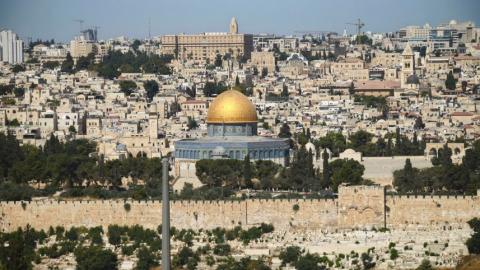Jewish Presence on the Temple Mount
To mark the state’s 19th birthday in 1967, then-Jerusalem Mayor Teddy Kollek commissioned an uplifting song from Naomi Shemer for that year’s Independence Day celebrations. In “Jerusalem of Gold,” Shemer did not praise David Ben-Gurion’s bold decision to move the capital to Jerusalem, nor did she glorify the sovereignty of the Knesset, the acquisition of knowledge at the university or the art in the museum. Instead, she wrote about longing for the Temple Mount that was under Jordanian control: “And no one visits the Temple Mount / In the Old City.”
Three weeks later, King Hussein of Jordan ignored the Israeli entreaties and allowed himself to be deceived by Egypt. And so during the Six-Day War he shelled Tel Aviv and his forces attacked Armon Hanatziv in Jerusalem. Then-Defense Minister Moshe Dayan, whose orders shaped the dimensions of the war, was faced with the dilemma of whether to conquer the Temple Mount. Dayan and National Religious Party leader Haim-Moshe Shapira understood this was a wealth that would do its owners ill. According to one account (by Arieh Brown and Mordechai Bar-On), Dayan – viewing the site from Mount Scopus – asked, “What do we need this Vatican for?”
Circumstantial evidence suggests Dayan merely wanted to surround the Old City and force King Hussein to make a commitment (already made by his grandfather Abdullah, but violated by the Jordanians over the years) to allow Jews to pray at the Western Wall. But then-Prime Minister Levi Eshkol, Minister Menachem Begin and Labor Minister Yigal Allon pressed Dayan to conquer the city, and the paratroopers burst onto the Temple Mount.
Then Dayan made a strategic decision to leave management of the Mount in the hands of the Waqf (the Muslim religious trust) on the basis of “What was will be.” Despite the changes that have occurred since then, it was a wise decision for the time, and still is.
The government understood that the Temple Mount was not just another plot under Israeli sovereignty. Allon drew up a plan in which the Arabs would reach the mosques via a bridge, without stepping on Israeli soil. There were rumors of a plan by Dr. Yaakov Herzog and Moshe Sasson to have the Saudi flag fly over the mosques. The next major incident was in 2000. Then-Prime Minister Ehud Barak broke a taboo and agreed to discuss the division of Jerusalem. Then-Palestinian Authority Chairman Yasser Arafat panicked that Barak might be serious and started to claim there had never been a temple on the Temple Mount. Then-U.S. President Bill Clinton was furious with him for trying to write Jesus out of history.
During the 100 years since the Balfour Declaration, there have been many violent incidents in the Temple Mount compound and at the Western Wall Plaza, and some of these developed into protracted bloody events. The July 14 murder of two Israeli policemen by attackers from Umm al-Fahm is another layer. The Israeli government expressed its understandable anger, but anger is a bad adviser. Prime Minister Benjamin Netanyahu hastily decided to install metal detectors and his ministers collectively answered amen. What was installed foolishly was removed by necessity, and the ministers, like a weathervane, again answered amen – with the premier trying to reap personal or party benefits from the ending of the embassy crisis in Amman.
The conclusion is that the history of the struggles on the Temple Mount is never the past, but always the present. This specific dispute is over, but the problem persists. It’s possible there is no solution to it yet, but if one is found, it will have to include an Israeli presence on the Temple Mount – but not an exclusive one. The visible presence on the Mount is Muslim. Jews are present on the Mount through the Temple ruins, which are hidden in the depths of the earth.
When tempers cool down and everyone has moved on, it would be wise to return to the Arab Peace Initiative of 2002 and discuss a solution with the Arab world that would allow international management (with Israel’s participation) of what was and remains “this Vatican.”
Dan Margalit

